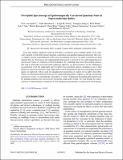Two-Qubit Spectroscopy of Spatiotemporally Correlated Quantum Noise in Superconducting Qubits
Author(s)
von Lüpke, Uwe; Beaudoin, Félix; Norris, Leigh M; Sung, Youngkyu; Winik, Roni; Qiu, Jack Y; Kjaergaard, Morten; Kim, David; Yoder, Jonilyn; Gustavsson, Simon; Viola, Lorenza; Oliver, William D; ... Show more Show less
DownloadPublished version (2.313Mb)
Publisher with Creative Commons License
Publisher with Creative Commons License
Creative Commons Attribution
Terms of use
Metadata
Show full item recordAbstract
Noise that exhibits significant temporal and spatial correlations across
multiple qubits can be especially harmful to both fault-tolerant quantum
computation and quantum-enhanced metrology. However, a complete spectral
characterization of the noise environment of even a two-qubit system has not
been reported thus far. We propose and experimentally validate a protocol for
two-qubit dephasing noise spectroscopy based on continuous control modulation.
By combining ideas from spin-locking relaxometry with a statistically motivated
robust estimation approach, our protocol allows for the simultaneous
reconstruction of all the single-qubit and two-qubit cross-correlation spectra,
including access to their distinctive non-classical features. Only single-qubit
control manipulations and state-tomography measurements are employed, with no
need for entangled-state preparation or readout of two-qubit observables. While
our experimental validation uses two superconducting qubits coupled to a shared
engineered noise source, our methodology is portable to a variety of
dephasing-dominated qubit architectures. By pushing quantum noise spectroscopy
beyond the single-qubit setting, our work paves the way to characterizing
spatiotemporal correlations in both engineered and naturally occurring noise
environments.
Date issued
2020Department
Massachusetts Institute of Technology. Research Laboratory of Electronics; Massachusetts Institute of Technology. Department of PhysicsJournal
PRX Quantum
Publisher
American Physical Society (APS)